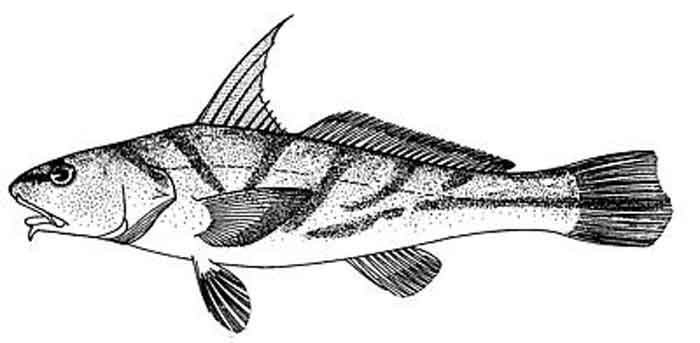Superregnum: Eukaryota
Cladus: Unikonta
Cladus: Opisthokonta
Cladus: Holozoa
Regnum: Animalia
Subregnum: Eumetazoa
Cladus: Bilateria
Cladus: Nephrozoa
Superphylum: Deuterostomia
Phylum: Chordata
Subphylum: Vertebrata
Infraphylum: Gnathostomata
Megaclassis: Osteichthyes
Superclassis/Classis: Actinopterygii
Classis/Subclassis: Actinopteri
Subclassis/Infraclassis: Neopterygii
Infraclassis: Teleostei
Megacohors: Osteoglossocephalai
Supercohors: Clupeocephala
Cohors: Euteleosteomorpha
Subcohors: Neoteleostei
Infracohors: Eurypterygia
Sectio: Ctenosquamata
Subsectio: Acanthomorphata
Divisio/Superordo: Acanthopterygii
Subdivisio: Percomorphaceae
Series: Eupercaria
Ordo: Perciformes
Subordo: Percoidei
Superfamilia: Percoidea
Familia: Sciaenidae
Genus: Menticirrhus
Species: M. americanus – M. elongatus – M. littoralis – M. nasus – M. ophicephalus – M. paitensis – M. panamensis – M. saxatilis – M. undulatus
Name
Menticirrhus Gill, 1861

Menticirrhus panamensis

Menticirrhus saxatilis
References
Santos, S., Gomes, M. d. F., Soares Ferreira, A. R., Sampaio, I. & Schneider, H.; 2012: Molecular phylogeny of the western South Atlantic Sciaenidae based on mitochondrial and nuclear data. Molecular Phylogenetics and Evolution, Available online 4 October 2012, In Press, Accepted Manuscript, abstract
Menticirrhus – Taxon details on Integrated Taxonomic Information System (ITIS).
Menticirrhus species list in FishBase,
Froese, R. & Pauly, D. (eds.) 2024. FishBase. World Wide Web electronic publication, www.fishbase.org, version 02/2024.
Vernacular names
English: Kingfishes, Kingcroakers
Menticirrhus is a genus of marine ray-finned fish belonging to the family Sciaenidae, the drums or croakers. They are commonly known as kingcroakers or kingfish. These fish are found in the Western Atlantic and Eastern Pacific Oceans.
Taxonomy
Menticirrhus was first proposed as a genus in 1861 by the American biologist Theodore Gill with Perca alburnus, a species described by Linnaeus in 1763 from Charleston, as its only species and designated as its type species.[3][4] This genus has been placed in the subfamily Sciaeninae by some workers,[5] but the 5th edition of Fishes of the World does not recognise subfamilies within the Sciaenidae which it places in the order Acanthuriformes.[6]
Etymology
Menticirrhus is a combination of mentum, meaning "chin", and cirrhus, which means barbel, an allusion to the single thick barbel on the chin.[7]
Species
Menticirrhus contains the following species:[8]
Menticirrhus americanus (Linnaeus, 1758) (Southern kingcroaker)
Menticirrhus elongatus (Günther, 1864) (Pacific kingcroaker)
Menticirrhus littoralis (Holbrook, 1847) (Gulf kingcroaker)
Menticirrhus nasus (Günther, 1868) (Highfin king croaker)
Menticirrhus ophicephalus (Jenyns, 1840) (Snakehead kingcroaker)
Menticirrhus paitensis Hildebrand, 1946 (Paita kingcroaker)
Menticirrhus panamensis (Steindachner, 1877) (Panama kingcroaker)
Menticirrhus saxatilis (Bloch & Schneider, 1801) (Northern kingfish)
Menticirrhus undulatus (Girard, 1854) (California kingcroaker)
Kingfish caught from the Great South Bay.
Characteristics
Menticirrhus kingfish have elongated bodies which have a rounded cross section and a flat underside. The head is long and low with a somewhat conical snout which protrudes past the horizontal mouth. There are slits and pores above the mouth with a short, stout barbel on the chin with a pore at its tip and a number of pores at its base. The preoperculum may be smooth or weakly serrated and the gill cover is incised at its angle. The dorsal fin is supported by between 10 and 13 flexible sins and between 19 and 27 soft rays while the anal fin has a single weak spine and 7 to 9 soft rays. The scales are small and ctenoid.[9] The largest species in the genus is the California kingcroaker (M. undulatus) which has a maximum published total length of 71 cm (28 in) and the smallest is the Paita kingcroaker (M. paitensis) which has a maximum published total length pf 40 cm (16 in).[8]
Distribution
Menticirrhus fishes are found in the eastern Pacific between California and Peru and in the western Atlantic from Massachusetts in the north to northern Argentina.[10][11]
References
Sepkoski, Jack (2002). "A compendium of fossil marine animal genera". Bulletins of American Paleontology. 364: 560. Archived from the original on 2009-02-20. Retrieved 2008-01-08.
Nicolas Bailly (2011). "Menticirrhus Gill, 1861". WoRMS. World Register of Marine Species. Retrieved 2012-03-06.
Eschmeyer, William N.; Fricke, Ron & van der Laan, Richard (eds.). "Genera in the family Sciaenidae". Catalog of Fishes. California Academy of Sciences. Retrieved 29 May 2023.
Eschmeyer, William N.; Fricke, Ron & van der Laan, Richard (eds.). "Species in the genus Menticirrhus". Catalog of Fishes. California Academy of Sciences. Retrieved 29 May 2023.
Kunio Sasaki (1989). "Phylogeny of the family Sciaenidae, with notes on its Zoogeography (Teleostei, Peciformes)" (PDF). Memoirs of the Faculty of Fishes Hokkaido University. 36 (1–2): 1–137.
J. S. Nelson; T. C. Grande; M. V. H. Wilson (2016). Fishes of the World (5th ed.). Wiley. pp. 497–502. ISBN 978-1-118-34233-6.
Christopher Scharpf & Kenneth J. Lazara, eds. (9 March 2023). "Series Eupercaria (Incertae sedis): Families Callanthidae, Centrogenyidae, Dinopercidae, Emmelichthyidae, Malacanthidae, Monodactylidae, Moronidae, Parascorpididae, Sciaenidae and Sillagidae". The ETYFish Project Fish Name Etymology Database. Christopher Scharpf and Kenneth J. Lazara. Retrieved 29 May 2023.
Froese, Rainer and Pauly, Daniel, eds. (2023). Species of Menticirrhus in FishBase. February 2023 version.
"Genus: Menticirrhus, Kingfish Croaker, King-Croakers". Shorefishes of the Greater Caribbean online information system. Smithsonian Tropical Research Institute. Retrieved 29 May 2023.
Froese, Rainer; Pauly, Daniel (eds.) (2023). "Menticirrhus undulatus" in FishBase. February 2023 version.
Froese, Rainer; Pauly, Daniel (eds.) (2023). "Menticirrhus americanus" in FishBase. February 2023 version.
Retrieved from "http://en.wikipedia.org/"
All text is available under the terms of the GNU Free Documentation License

